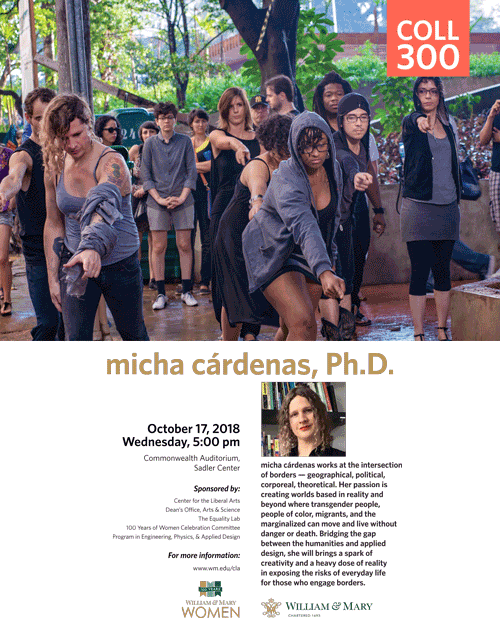micha cárdenas
 micha cárdenas PhD, has been using technology for art and social justice for over a decade. Inspired by her Latinx spiritual ancestors Gloria Anzaldúa and Sylvia Rivera, she works to challenge borders of all kinds, including borders between academia and activism, poetry and politics. Her current passion is combining theory and practice to consider how algorithms are like rituals, recipes and poems, and can be used for racial and gender justice. cárdenas is writing a new algorithm for gender, race and technology. Her current work uses algorithms to try to reduce violence against trans women of color. She is Assistant Professor of Art & Design: Games + Playable Media at the University of California, Santa Cruz. cárdenas’s co-authored books The Transreal: Political Aesthetics of Crossing Realities (2012) and Trans Desire / Affective Cyborgs (2010). cárdenas, a first generation Colombian-American, is an artist/theorist and the inaugural recipient of the James Tiptree Jr. fellowship in 2014, a fellowship to provide support and recognition for the new voices in science fiction who are making visible the forces that are changing our view of gender today. Her artwork has been described as “a seminal milestone for artistic engagement in VR” by the Spike art journal in Berlin. Her visit occurred October 17-19, 2018.
micha cárdenas PhD, has been using technology for art and social justice for over a decade. Inspired by her Latinx spiritual ancestors Gloria Anzaldúa and Sylvia Rivera, she works to challenge borders of all kinds, including borders between academia and activism, poetry and politics. Her current passion is combining theory and practice to consider how algorithms are like rituals, recipes and poems, and can be used for racial and gender justice. cárdenas is writing a new algorithm for gender, race and technology. Her current work uses algorithms to try to reduce violence against trans women of color. She is Assistant Professor of Art & Design: Games + Playable Media at the University of California, Santa Cruz. cárdenas’s co-authored books The Transreal: Political Aesthetics of Crossing Realities (2012) and Trans Desire / Affective Cyborgs (2010). cárdenas, a first generation Colombian-American, is an artist/theorist and the inaugural recipient of the James Tiptree Jr. fellowship in 2014, a fellowship to provide support and recognition for the new voices in science fiction who are making visible the forces that are changing our view of gender today. Her artwork has been described as “a seminal milestone for artistic engagement in VR” by the Spike art journal in Berlin. Her visit occurred October 17-19, 2018.
Public Event
Fall 2018 Theme: Bodies That Matter
Whether exploring the complex interactions of celestial forces or contemporary questions of social justice, scholars recognize that all bodies exist within broader systems that create parameters of possibility for their significance and action. Fundamental questions include, how do some bodies exert disproportionate force? How are bodies conceptualized differently in distinct contexts across the globe? What chain reactions in knowledge, power, or organization ensue when new bodies are introduced into existing systems? How do bodies transform their surrounding environments? And how can scholars stimulate recognition of overlooked, undervalued, or alienated bodies?














